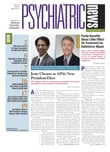Thus far, my presidential year has been one of significant growth—increased understanding of some of the complexities facing our field and the challenges in communicating complex interactions effectively. I also have become more and more intrigued by how different forms of communication used by the four generations currently in the psychiatric workplace affect education and training as well as the patients we treat. These new forms of electronic communication—including electronic mail, texting over cell phones, instant messaging, video chatting, tweeting, and Facebook have revolutionized political events around the world. As psychiatrists and experts in human behavior, I believe we can make unique contributions to the dialogue about how to move forward in this "brave new world."
Recent events in Arizona and Egypt provide contrasting examples of ways in which new styles of communication can both harm and enhance human interaction. While we don't know what motivated the shooting spree in Tucson, we are all aware that external stimuli may differentially influence some in our society. Specifically, a culture in which violence and vitriol are accepted as appropriate means of communication may contribute to acting on feelings and beliefs by more vulnerable persons—particularly those who are immature or whose sense of reality is already impaired. I do not mean to suggest that psychiatric patients alone are affected by this type of climate, but rather that modes of communication that take place more anonymously such as on the Web and cell phones may have the unintended consequence of contributing to alienation, misunderstanding, and perhaps even illness. The ease with which information can be cut, pasted, and distorted with great facility and similarly how photographs and images on Web sites can be altered and manipulated have made us raise a questioning eyebrow at a lot of communication that comes our way. Such unreliable or insufficient communication provides multiple opportunities to engender misunderstanding and mistrust, and it can prevent appreciation of the nuances of scientific reports or policy options.
Moreover, our 24/7 media environment has embraced "sound bites" and "tweets" as acceptable means of communication. Such forms of brief commentary may lead to miscommunication and misunderstanding, as well as further inflame distrust and contribute to distortion and ill will.
These new forms of individuals and group interaction also present a challenge for APA in determining how best to connect with our large membership on a more personal level. At town hall meetings I have held with our newer and younger members, who are savvy about new technology, we have had many discussions about the best ways to improve information sharing about APA. While APA staff are updating and redesigning our Web site, this is only part of the solution. Most of us are deluged with information and are routinely confronted with a need to separate out what is important from what is not.
While the younger generation has more rapidly adopted much of the new technology, many in the "older" generation of psychiatrists have been reluctant to do so. However, those of us in the "older generation" must develop both an appreciation for and an understanding of the value and importance of the newer ways to communicate, especially the use of social networks and other features of the Internet. These new modalities can contribute to revolutionary change as we have seen through recent events in parts of the Middle East and North Africa and expand opportunities for us to interact with our patients in different ways. We should value social network phenomena but collaborate to develop ways to expand the personal side of communication. Anonymous, one-dimensional communications from those we don't know are likely to be discarded and/or distorted, and, if passed on, may reinforce negative constructs and alienation. Alternatively, if we can integrate personal, in-depth messages through the social connections now available with new technology, we should be able to both enhance our ability to share accurate information rapidly and widely and contribute to a richer, more nuanced understanding of some of the factors that influence how we behave and interact with each other.

